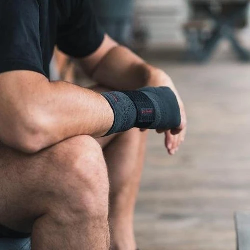When asked for their reasons for avoiding exercise, patients often blame pain and a lack of confidence due to perceived joint instability.
Such barriers to activity can be the first steps on a downwards slope to more serious health conditions, which is why it is so important for these patients to maintain a healthy level of activity in their daily lives.
An easy, low-cost way to address the symptoms that prevent exercise is soft bracing. Soft braces are elastic and non-adhesive orthoses often used to reduce barriers to activity.(1)
Soft braces achieve this by:
• Improving joint proprioception (1,5)
Proprioception is the body's ability to sense its own location, movements, and actions. Soft braces supposedly act on sensory receptors in the skin that contribute to improvements in proprioception (1,2,5)
• Reducing pain (1,6)
Tactile stimulation provided by a soft brace can cause neural inhibition leading to the reduction of pain signals (1,2)
• Improving joint stability (1,7)
Mechanical effects are usually associated with soft bracing. However, it has been suggested that a reduction in joint instability may be the result of additional sensory input from the brace, leading to improvements in proprioception (1,2)
Why use a soft brace?
• Ease of use
With mechanical bracing, despite improvements in patient reported outcomes, there is an unwillingness amongst patients to wear these braces for prolonged periods (3,4)
• Low cost
Soft bracing is mostly designed for compression and is usually elasticated. Due to the lack of hinges and metallic material, they are usually significantly cheaper than mechanical alternatives
• Improve patient compliance
Mechanical bracing is sometimes associated with poor compliance due to factors such as skin irritation, discomfort, bad fit, bulkiness, practicality, and social stigma (5)
Introducing elastic knitted supports from DonJoy®
DonJoy® began life in 1978 when two ex-professional American Football players cut up their old wetsuits to make knee supports, and the company has since gone on to become a major player in the field of orthopedic and sports medicine bracing.
Continuing its track record of delivering high quality, practical products for sports and everyday activities, DonJoy now introduces a new line of soft active supports to help prevent and recover from injuries.
Comprising ten options for the ankle, knee, elbow, and wrist, this range combines supportive yet adjustable features with lightweight, adaptable materials to help provide:
• Prevention
• Protection
• Stabilization
• Compression
• Support
• Proprioception
Each product’s knitted construction uses a multidirectional elastic fabric which helps provide effective and targeted compression and support. This elastic material is also soft and breathable for enhanced comfort, which is further provided by compression-reduced edges that help divert pressure at the ends of the support.
The range comprises:
Attractive and ergonomic, these supports won’t compromise style or comfort, leaving patients feeling confident and free to continue an active lifestyle.
References
1. Cudejko T, van der Esch M, van den Noort JC, Rijnhart JJ, van der Leeden M, Roorda LD, Lems W, Waddington G, Harlaar J, Dekker J, 2019. Decreased pain and improved dynamic knee instability mediate the beneficial effect of wearing a soft knee brace on activity limitations in patients with knee osteoarthritis. Arthritis care & research 71 (8), pp.1036 1043.
2. Hassan BS, Mockett S, Doherty M. Influence of elastic bandage on knee pain, proprioception, and postural sway in subjects with knee osteoarthritis . Ann Rheum Dis 2002;61:24 8.
3. Cudejko T, van der Esch M, van der Leeden M, van den Noort JC, Roorda LD, Lems W, Twisk J, Steultjens M, Woodburn J, Harlaar J, Dekker J. The immediate effect of a soft knee brace on pain, activity limitations, self-reported knee instability, and self-reported knee confidence in patients with knee osteoarthritis. Arthritis Res Ther. 2017 Dec 1;19(1):260.
4. Beaudreuil J, Bendaya S, Faucher M, Coudeyre E, Ribinik P, Revel M, Rannou F. Clinical practice guidelines for rest orthosis, knee sleeves, and unloading knee braces in knee osteoarthritis. Joint Bone Spine. 2009 Dec;76(6):629-36.
5. Kwaees, T.A., Richards, J., Rawlinson, G., Charalambous, C.P. and Chohan, A., 2019. Can the use of proprioceptive knee braces have implications in the management of osteoarthritic knees: An exploratory study. Prosthetics and orthotics international, 43(2), pp.140-147.
6. Sinclair JK, Selfe J, Taylor PJ, Shore HF, Richards JD. Influence of a knee brace intervention on perceived pain and patellofemoral loading in recreational athletes. Clin Biomech (Bristol, Avon). 2016 Aug;37:7-12.
7. Sinclair, JK, Vincent, H, Richards, JD. Effects of prophylactic knee bracing on knee joint kinetics and kinematics during netball specific movements. Physical therapy in sport : official journal of the Association of Chartered Physiotherapists in Sports Medicine. 2018; 23, 93–98.

